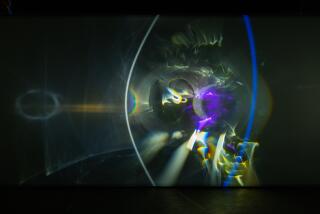In Lara Schnitger’s fabric art, truth stretches into fantasy
Art, people often say, holds a mirror up to society. At Grice Bench gallery in Atwater Village, “Lara Schnitger: Victory Garden” suggests that looking in mirrors is tricky business: What you see there is a mixture of appearance and reality.
In mirrors and art, fact and fiction intermingle. Dreams and dread collide and commingle. The same goes for illusions and truths. Most important, selves and others switch positions.
Art invites us to see ourselves differently and allows us to experience the otherness of our very selves — no longer unified and singular, but fractured and multiple. Identity is made fluid and elusive, something to pursue or run from.
All that happens in Schnitger’s L.A. solo debut, which is also a whole lot of fun.
OTIS: Art school’s president is out »
Step into the main space and you’ll find yourself in tight quarters with three wall-works. One is a portrait of Judith, holding the head of Holofernes, which she has just lopped off. Another, on translucent pink scrim, is the silhouette of two hands holding up undergarments that, when worn, would leave very little to the imagination. Death and sex bring Freud front and center.
But “Lesbos,” the third and largest work, presents things the father of psychoanalysis would be hard-pressed to make sense of.
The nearly 8- by 13-foot collage is a microcosm of the exhibition. In it, seven women appear. Five occupy the foreground. One appears in an oval mirror. And another floats, like a 3-D apparition, on a seemingly solid wall, its plaid wallpaper no match for the ghostly woman’s magic.
From where you stand, you can see the other pieces — two collages, two freestanding sculptures and two wall-mounted sculptures. But you can’t get to them because they are behind “White Widow,” a scrim made of nylons and chopsticks, that bisects the space.
The only way to see the rest of the exhibition up close is to leave the main space, by way of the second gallery, and then to return, on the other side of “White Widow.”
ARTADIA: Cash awards to Ron Athey, Carmen Argote and Diedrick Brackens »
Installed there are a pair of flat wall-works, a freestanding sculpture, “Judith’s Sis,” and a trio of wall-mounted sculptures: “Slutstick-Durga” “Slutstick-Barbells” and “Slutstick-Sidekick.” The four sculptures may be the best works in the exhibition. The slapped-together simplicity of their materials — sweaters, earrings and wigs — is belied by their power to evoke fin-de-siècle Vienna, cabarets in West Berlin, totems cobbled from flotsam, urban scarecrows and Beverly Hills mannequins — made by someone with a wicked sense of humor and more formal rigor than usually accompanies such attitude.
Back in the main space, Schnitger continues to play fast and loose with form and function, combining references and associations so promiscuously that standing back and presuming to be objective is not an option. Inviting visitors to reflect on reflections, the Netherlands-born, L.A.-based artist lures people of all stripes into a game of let’s pretend.
Grice Bench, 3423 Casitas Ave., L.A. Wednesdays-Sundays, through March 30. (323) 522-3323, www.gricebench.com
Support our coverage of local artists and the local arts scene by becoming a digital subscriber.
See all of our latest arts news and reviews at latimes.com/arts.
More to Read
The biggest entertainment stories
Get our big stories about Hollywood, film, television, music, arts, culture and more right in your inbox as soon as they publish.
You may occasionally receive promotional content from the Los Angeles Times.










